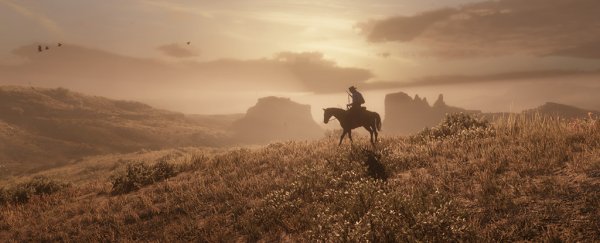The hugely successful Red Dead Redemption 2 (RDR2) video game puts you in a vast, open-world American West setting at the very end of the 19th century. Players can loot trains, shoot rival gang members, steal horses – and, it turns out, learn a lot about nature, too.
Researchers surveyed 586 volunteers from 55 different countries, 444 of whom had played RDR2, and found that those with experience of the game were better at identifying real-life animals shown to them in photos.
That's most likely down to the 200 or so real species of animals that are authentically rendered in RDR2 – they can all be interacted with and hunted, and they all act in similar ways to how they would in the wild.
"The level of detail in Red Dead Redemption 2 is famously high, and that's certainly the case in terms of animals," says environmental social scientist and anthrozoologist Sarah Crowley, from the University of Exeter in the UK.
"Many of the animals not only look and behave realistically, but interact with each other. Possums play dead, bears bluff charge and eagles hunt snakes."
For the study, participants had to identify 15 real species featured in the game from photographs, including the white-tailed deer, jackrabbit, alligator snapping turtle, lake sturgeon, pronghorn, green iguana, American bullfrog, blue jay, and roseate spoonbill.
When presented with a multiple choice quiz on these animals, RDR2 players got a median score of 10 out of 15 questions, whereas those who had no experience of the game had a median score of 7. The difference was greatest for those animals that are actually useful in the game – such as fish that can be caught and eaten.
Those who had completed the main RDR2 storyline (which takes around 40-60 hours of gameplay), those who had played the game most recently, and those who had taken on a conservationist role in the online version of RDR2 scored most highly.
Players also reported actually learning about animal behavior and ecology through Red Dead Redemption 2. One participant said the game had taught them how to spot a ram that was about to charge in the wild.
"The game features a couple of species that are now much rarer, and one – the Carolina parakeet – that's extinct," says ecologist Matthew Silk, from the University of Exeter.
"Hunting played a role in the Carolina parakeet's extinction; if players shoot this species in the game, they are warned of their endangered status. If they continue shooting, the species becomes extinct, highlighting the environmental consequences of players' actions."
Video games are often associated with long hours spent indoors away from nature, but the researchers are keen to emphasize their educational value – even if the main goal is entertainment, which helps to attract as many gamers as RDR2 has, people can still be learning while they play.
The team behind the study argues that games are "underexplored and underused" as methods of teaching, and that ecologists and conservationists should start taking titles such as Red Dead Redemption 2 - a game that's sold over 37 million copies to date - more seriously when it comes to increasing awareness about the natural world.
With many species currently in a perilous position in terms of future survival, and large parts of our planet slowly becoming more inhospitable, video games could be one of the methods used to encourage us to take better care of the world around us.
"We know that many gamers value realism, so game producers might be interested to see these findings, but we realise these games aren't designed to be educational," says biologist Ned Crowley, from Truro and Penwith College in the UK.
"We don't expect big-budget games to include messages about conservation, but educators and conservationists can learn from the techniques used in games – such as making things immersive, and having each action mean something in terms of wider progress in the game."
The research has been published in People and Nature.
